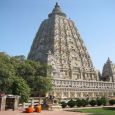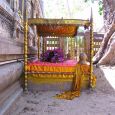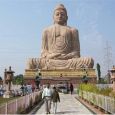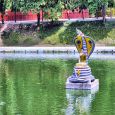Bodhgaya
Advertisement
By Air
5 kilometres from Bodhgaya is the Gaya Airport also known as Bodhgaya Airport.
By Train
Gaya Junction is the nearest railhead, which is 15 km away from Bodh Gaya. Gaya junction is connected to major cities in state by rail. Taxi charges for travel from railway station to city is about Rs 300.
By Bus
Bodh Gaya to Varanasi Bus service (Rs. 400)
Varanasi to Kathmandu Bus service (Rs. 1000)
Mahabodhi Temple
Mahabodhi Templeis located about 96 kilometres from Patna,it contains the Mahabodhi Temple with the diamond throne (called the Vajrasana) and the holy Bodhi tree. This tree was originally a sapling of the Sri Maha Bodhi tree in Sri Lanka, itself grown from a sapling of the original Bodhi tree.
It is believed that 250 years after the Enlightenment of the Buddha, Emperor Asoka visited Bodh Gaya. He is considered to be the founder of the original Mahabodhi temple. It consisted of an elongated spire crowned by a miniature stupa and a chhatravali on a platform. A double flight of steps led up to the platform and the upper sanctum. The mouldings on the spire contained Buddha images in niches. Some historians believe that the temple was constructed or renovated in the 1st century during the Kushan period. With the decline of Buddhism in India, the temple was abandoned and forgotten, buried under layers of soil and sand.The temple was later restored by Sir Alexander Cunningham as part of his work for the British Archaeological Society in the late 19th century. In 1883, Cunningham along with J. D. Beglar and Dr Rajendralal Miitra painstakingly excavated the site. Extensive renovation work was carried out to restore Bodh Gaya to its former glory.
Bodhi Tree
Bodhi Tree also known as Bo (from the Sinhalese Bo), was a large and very old Sacred Fig tree (Ficus religiosa) located in Bodh Gaya (about 100 km (62 mi) from Patna in the Indian state of Bihar), under which Siddhartha Gautama, the spiritual teacher and founder of Buddhism later known as Gautama Buddha, is said to have achieved enlightenment, or Bodhi. In religious iconography, the Bodhi tree is recognizable by its heart-shaped leaves, which are usually prominently displayed. It takes 100 to 3,000 years for a bodhi tree to fully grow.
The term "Bodhi Tree" is also widely applied to currently existing trees, particularly the Sacred Fig growing at the Mahabodhi Temple, which is a direct descendant of the original specimen. This tree is a frequent destination for pilgrims, being the most important of the four main Buddhist pilgrimage sites. Other holy Bodhi trees which have a great significance in the history of Buddhism are the Anandabodhi tree in Sravasti and the Bodhi tree in Anuradhapura, Sri Lanka. Both are believed to have been propagated from the original Bodhi tree.
Muchalinda Lake
Muchalinda Lake is to the right of the main temple and a statue of meditating Buddha sitting on a snake coil and protected by the hood is at the centre of the Lake. The Lake is surrounded by lines of green trees.Buddha is also believed to be an incarnation of Lord Vishnu and it is at the Lake Muchalinda that the SheshNaga or the Snake King Muchalinda protected his Lord from a severe thunder storm. The Buddha was meditating near the Lake during the sixth week when a strong storm broke out and the Lake waves started lashing the Buddha. Sensing the discomfort of the Lord the Snake King decided to protect him from the storm.
Royal Bhutan Monastery
Royal Bhutan Monastery the town of Bodh Gaya has been the center of attraction for millions of Buddhism followers as well as the historians equally. This influx has not been limited only within the country and various governments have constructed their Monasteries and temples in the vicinity. The Royal Bhutan Monastery has been constructed by the King of Bhutan as a mark of respect to the Lord.The monastery is well maintained and is unique because of the singular fact that the interior walls of the monastery have peculiar clay carvings depicting various aspects of Buddhism. The monastery welcomes all visitors.
Vietnamese Temple
Vietnamese Temple buddhism had reached Vietnam very early and was eagerly adopted by its people. The Government of Vietnam decided to dedicate a temple to the Lord and recently (in 2002) the Vietnamese temple was constructed near the Maha Bodhi temple complex. Being the most recent the temple has had all the advantages of science with it and has been exquisitely constructed with serene surroundings and beautiful vicinity.The extremely calm and serene statue of Avalokiteswara, or the very peaceful Buddha is housed within the sanctum of the temple. The statue appears to be smiling and absorbing the peaceful atmosphere around it.
Great Buddha Statue
Great Buddha Statue the main Bodhi Shrine is surrounded by numerous religious and spiritual monuments and institutes.The Great Buddha statue standing tall at a height of 80 ft is one such attraction which pulls the visitors toward it with its overpowering presence and towering aura. Arguably the tallest Buddha statue in the country,it was inaugurated on 18 Nov 1989 by the XIVth Dalai Lama.This huge figurine depicts Lord Buddha meditating (dhyana mudra) while he is seated on a giant lotus in open air. An inspirational image near the Bodhi Shrine the Great Buddha Statue, is a mix of sandstone blocks and red granite.
Archaeological Society of India Museum
Archaeological Society of India Museum the town of Bodh Gaya and its surroundings are replete with numerous archeological sites, some dating back right to the grand Neolithic Age (2,500 BC). The rich history of being an Educational Powerhouse and trade center is being time and again proved through these excavations.The Archeological Society of India Museum houses numerous artifacts and excavated articles which point towards the extraordinary and modern lifestyle of the residents of the buried societies.The museum has restored and displayed many old scriptures and educational aids which were utilised by then Universities to train their students who were from far flung places such as China and Mongolia.
Dungeswari Hills
Dungeswari Hills at a distance of approximately 15 km from Bodh Gaya, the Dungeswari hills form a picturesque backdrop for the handful shrines and ancient Stupas which surround the cave which is believed to have protected prince Gautama for six long years before he finally left for Bodh Gaya and attained enlightenment. The prince had left all his earthly belongings and had accepted a life of suffering and misery.However, the six years spent in the cave proved futile since the prince was disillusioned and moved on to other places in search of true knowledge. Situated along the river Phalgu these hills and the cave find a proud mention in the travel logs of Fa Hein as well as Huen Tsang.
October - March
June - September






